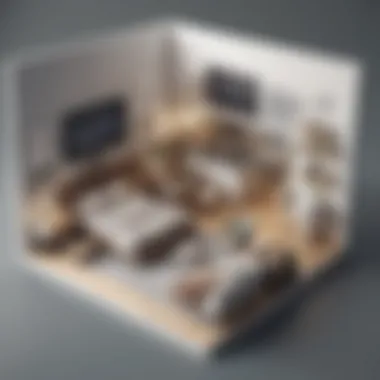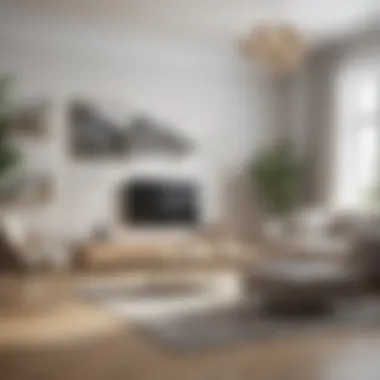Revolutionizing Room Decor: The Ultimate Guide to Software Selection for Transformative Designs


Software Overview
In this section, we will delve into the cutting-edge software options available for revolutionizing room decor. From introducing the software to highlighting its key features and functionalities, we aim to provide a detailed overview that caters to the needs of small to medium-sized businesses, entrepreneurs, IT professionals, and decision-makers. Furthermore, a comprehensive look into the pricing plans and available subscriptions will be provided to assist readers in making informed choices.
User Experience
Moving forward to the user experience aspect, we will analyze the user interface and navigational elements of the software under consideration. We will discuss the ease of use and learning curve of the software to provide insights into how seamlessly it can be integrated into various businesses. Additionally, our examination will extend to the customer support options available and the reliability of the software in delivering on its promises.
Performance and Reliability
Performance and reliability play a crucial role in determining the effectiveness of software for room decor enhancement. This section will focus on evaluating the speed and efficiency of the software, providing in-depth analysis backed by statistical data. Furthermore, the uptime and downtime statistics will be meticulously examined to gauge the software's reliability. Additionally, the integration capabilities of the software with other tools will be explored to assess its adaptability and scalability.
Security and Compliance
Ensuring the security and compliance of the software is paramount in the digital age. We will delve into the data encryption and security protocols implemented by the software to safeguard sensitive information. Moreover, the software's compliance with industry regulations will be scrutinized to ensure that it meets the necessary standards. Backup and disaster recovery measures will also be considered to provide readers with a comprehensive understanding of the software's reliability in facing unforeseen challenges.
Introduction
Software choices can play a pivotal role in the realm of room decor, offering innovative solutions that cater to the evolving needs of businesses and individuals alike. Embracing software for room decoration not only enhances efficiency but also ignites the spark of creativity, transforming spaces into expressions of unique personalized styles. Understanding the impact of software in room decoration delves into the core of how technology revolutionizes design processes and elevates user experiences. Expanding our horizons beyond conventional decor practices, software integration opens up a realm of endless possibilities and practical solutions for both professionals and enthusiasts.
Understanding the Impact of Software in Room Decoration
Innovations in room decor
Innovations in room decor represent a leap towards modernization and efficiency in spatial design. By harnessing cutting-edge technologies, such as augmented reality and AI, software tools empower designers with versatile means of visualizing concepts and bringing them to life with unparalleled accuracy. The fusion of artistry and technology cultivates a dynamic environment where creativity thrives and new design frontiers are explored. The intrinsic value of these innovations lies in their ability to streamline design processes, enhance project visualization, and cater to the diverse needs of clients and decorators alike.
Role of technology in design
The role of technology in design goes beyond mere facilitation; it serves as a catalyst for redefining conventional design paradigms. By leveraging tech-driven tools and platforms, designers can transcend limitations, test boundaries, and manifest intricate design concepts with precision. Technology acts as a pivotal force in bridging the gap between imagination and realization, offering a medium through which design aspirations can materialize seamlessly. While the advantages of technology in design are abundant, including faster project turnaround times and improved project management, it also presents challenges such as the need for continuous upskilling and adaptation to emerging technological trends.
Significance of Choosing the Right Software
Efficiency in design processes
Efficiency in design processes stands as a cornerstone in determining the efficacy of software solutions for room decor. The seamless integration of software tools not only expedites the design workflow but also enhances collaboration among team members and stakeholders. Features such as real-time rendering, customizable templates, and cloud-based storage elevate the design experience, enabling designers to focus on creativity rather than operational intricacies. Choosing software that prioritizes efficiency instills a competitive edge, fostering agility and adaptability in an ever-evolving design landscape.


Enhancing user experience
Enhancing user experience encompasses the user-centric approach of software selection, emphasizing intuitive interfaces, interactive functionalities, and personalized design options. Software that caters to user preferences not only simplifies the design process but also cultivates a sense of ownership and satisfaction among users. The emphasis on user experience fosters brand loyalty, drives customer engagement, and positions software tools as indispensable assets in the realm of room decor. Prioritizing user experience in software selection not only maximizes usability but also paves the way for continuous innovation and user-driven product enhancements.
Exploring Room Decoration Software
In the realm of interior design, leveraging software has become imperative for creating visually stunning spaces. The section 'Exploring Room Decoration Software' delves into the crux of selecting the right tools to revolutionize room decor. By focusing on specific elements like functionality, ease of use, and design capabilities, this article sheds light on the importance of software in enhancing the aesthetics of living and working areas. Understanding the intricacies of different software options is crucial for small to medium-sized businesses, entrepreneurs, and IT professionals looking to streamline their design processes and offer innovative solutions to clients.
Top Features to Look For
3D Modeling Capabilities
When it comes to room decoration software, the inclusion of robust 3D modeling capabilities is paramount. This feature enables users to visualize spaces in three dimensions, providing a realistic representation of the final design. The ability to manipulate objects, textures, and lighting in a virtual environment enhances the overall design process, allowing for greater precision and customization. In this article, the significance of 3D modeling capabilities lies in its capacity to bring concepts to life and facilitate clear communication between designers and clients.
Customization Options
Another essential aspect to consider when exploring room decoration software is the availability of customization options. These features allow users to tailor designs to meet specific requirements and preferences, resulting in unique and personalized spaces. The flexibility provided by customization tools empowers designers to unleash their creativity and adapt designs according to individual needs. While the abundance of customization options can offer great versatility, it is important to strike a balance between creative freedom and practicality for an optimal user experience.
Benefits of Virtual Room Designing
Cost-Effective Solutions
Virtual room designing not only streamlines the design process but also offers cost-effective solutions for businesses. By eliminating the need for physical prototypes and minimizing material wastage, virtual design tools help reduce expenses associated with traditional design methods. This cost-efficiency makes virtual room designing a popular choice for businesses aiming to optimize their resources and deliver quality results within budget constraints.
Visualization of Concepts
One of the key benefits of virtual room designing is the enhanced visualization of concepts. Through interactive virtual environments, designers can present ideas in a more engaging and comprehensive manner, allowing clients to visualize the end result more effectively. The ability to experiment with different layouts, colors, and styles in a virtual setting enhances decision-making processes and encourages exploration of creative possibilities.
Popular Room Decoration Software Tools
Tool A: VirtualRoomPro
VirtualRoomPro stands out as a versatile software tool that offers a wide range of functionalities for room decoration. Its intuitive interface and diverse library of design elements make it a popular choice among designers seeking efficiency and creativity in their projects. A unique feature of VirtualRoomPro is its real-time collaboration capabilities, allowing multiple users to work on a project simultaneously and share ideas seamlessly. While the tool enhances teamwork and productivity, its complexity may require some training to fully harness its potential.
Tool B: DecorifyNow


DecorifyNow caters to users looking for a user-friendly and intuitive software solution for room decoration. Its emphasis on user experience and simplicity makes it an attractive option for beginners and professionals alike. The unique feature of DecorifyNow lies in its pre-built templates and design suggestions, providing users with inspiration and guidance for their projects. While DecorifyNow offers ease of use and accessibility, some users may find its customization options relatively limited compared to more advanced software tools.
Implementing Software in Room Decor Projects
In this section of the article, we delve into the crucial aspect of implementing software in room decor projects, a pivotal topic that serves as the foundation for transforming design processes. Understanding the significance of integrating software solutions is paramount for small to medium-sized businesses, entrepreneurs, and IT professionals looking to enhance their room decoration capabilities. By focusing on specific elements such as efficiency, creativity, and user experience, the implementation of software becomes a strategic tool for achieving design excellence.
Best Practices for Integration
Collaboration with Designers
Collaboration with designers stands out as a key driver in the successful implementation of room decor software. This collaborative approach fosters a harmonious relationship between tech-driven solutions and creative vision, resulting in innovative design outcomes. The seamless integration of design expertise alongside technological functionalities enriches the overall project delivery, ensuring a balance between aesthetics and practicality. The unique feature of collaboration lies in its ability to bridge the gap between traditional design methods and modern software applications, offering a synergistic blend of artistic flair and digital precision.
Training for Team Members
The training of team members plays a vital role in streamlining the implementation process of software in room decor projects. Equipping staff with the necessary skills and knowledge elevates the proficiency levels within the organization, empowering individuals to effectively leverage software tools for design tasks. The key characteristic of comprehensive training lies in its ability to enhance operational efficiency and optimize workflow management. While training demands an initial time investment, the long-term advantages of upskilling team members translate into enhanced productivity, improved design quality, and a seamless adoption of new technologies.
Maximizing Efficiency and Creativity
In the pursuit of design excellence, maximizing efficiency and creativity through software integration emerges as a top priority for businesses and professionals alike. By focusing on workflow optimization, organizations can streamline design processes, eliminate redundancies, and boost overall productivity. The key characteristic of workflow optimization lies in its ability to identify bottlenecks, restructure workflows, and introduce automation where necessary, resulting in smoother project completion and resource utilization.
Inspiration through digital platforms plays a pivotal role in nurturing creativity and driving innovation within design teams. By leveraging digital tools and online resources, individuals can draw inspiration from a myriad of sources, explore design trends, and experiment with new concepts. The unique feature of digital platforms lies in their ability to offer a vast repository of design ideas, tutorials, and industry insights, serving as a catalyst for creative ideation and design exploration.
Case Studies on Successful Integration
Company X: From Concept to Reality
The success story of Company X exemplifies the seamless integration of software in room decor projects, translating conceptual ideas into tangible design solutions. A key characteristic of Company X's approach is their commitment to embracing technological advancements and merging them with design expertise to deliver innovative spaces. This synergy between creativity and software functionality has enabled Company X to achieve unparalleled success in transforming visionary concepts into practical implementations, setting a benchmark for design excellence.
Company Y: Streamlining Design Processes
Company Y stands out for its emphasis on streamlining design processes through the effective integration of software tools and employee training programs. The key characteristic of Company Y lies in its systematic approach to optimizing workflows, enhancing team collaboration, and fostering a culture of continuous improvement. By leveraging efficient software solutions and investing in employee development, Company Y has managed to streamline its design operations, elevate productivity levels, and deliver exceptional results to clients.
Future Trends in Room Decor Software
The future trends in room decor software play a pivotal role in shaping the landscape of room decoration practices. As technology continues to advance rapidly, it is crucial for businesses, entrepreneurs, and IT professionals to stay abreast of these developments. Embracing future trends in room decor software not only allows for staying competitive in the market but also opens up new possibilities for creativity and efficiency. By understanding and implementing these trends, individuals can unlock innovative solutions that cater to the evolving demands of the industry.


AI and Automation in Design
Enhancing Predictive Modeling
Enhancing predictive modeling in room decor software enables accurate forecasting of design outcomes based on historical data and user preferences. This sophisticated feature enhances the overall design process by streamlining decision-making and optimizing design choices. The key characteristic of enhancing predictive modeling lies in its ability to anticipate trends and customer needs, making it a valuable asset for this article. Its unique feature of analyzing vast amounts of data to generate personalized design suggestions provides a significant advantage, although challenges may arise in data accuracy and interpretation within the context of this article.
Personalization in Recommendations
Personalization in recommendations ensures that room decor software tailors suggestions based on individual preferences and behaviors. This personalized approach contributes to creating unique and engaging design experiences for users. The key characteristic of personalization lies in its ability to foster a deeper connection between users and the software, enhancing user satisfaction and loyalty. This feature is particularly beneficial for this article as it promotes user engagement and satisfaction. However, challenges may arise in data privacy and algorithm bias, requiring careful consideration in implementation.
Augmented Reality Applications
Interactive Visualizations
Interactive visualizations in room decor software offer an immersive and dynamic way to present design concepts and ideas. By allowing users to interact with virtual environments, this feature enhances user engagement and understanding of design layouts. The key characteristic of interactive visualizations is their ability to provide a realistic preview of design changes, making them a popular choice for this article. The unique feature of real-time adjustments based on user input provides an advantage in facilitating collaboration and decision-making. However, the complexity of implementing interactive features may pose challenges in software usability and performance optimization within the scope of this article.
Virtual Product Placements
Virtual product placements enable users to visualize and assess how different decor items fit within their space before making purchase decisions. This feature contributes to enhancing user confidence in design choices and streamlining the shopping process. The key characteristic of virtual product placements lies in their capacity to bridge the gap between design concepts and real-world implementation, making them a beneficial choice for this article. The unique feature of seamless integration with e-commerce platforms offers advantages in driving sales and expanding product visibility. Challenges may arise in product accuracy and user interface design, necessitating continuous refinement for optimal user experience.
Environmental Sustainability Features
Green Design Options
Green design options in room decor software promote environmentally friendly choices in material selection and design practices. By incorporating sustainable elements, businesses and designers can contribute to reducing ecological footprint and promoting green living. The key characteristic of green design options is their potential to resonate with environmentally conscious consumers, making them a popular choice for this article. The unique feature of integrating eco-friendly materials and processes offers advantages in market positioning and brand reputation. Challenges may arise in sourcing sustainable materials and balancing aesthetic appeal with environmental considerations, requiring a strategic approach for successful implementation.
Carbon Footprint Calculations
Carbon footprint calculations within room decor software enable users to quantify and mitigate the environmental impact of their design choices. By providing insights into carbon emissions associated with design decisions, this feature encourages sustainable practices and informed decision-making. The key characteristic of carbon footprint calculations is their contribution to fostering environmental awareness and accountability, making them a valuable choice for this article. The unique feature of generating customized sustainability reports offers advantages in promoting transparency and fostering a culture of sustainability. Challenges may arise in data accuracy and visualization of complex environmental data, necessitating clear communication and user-friendly interfaces for effective utilization.
Conclusion
In the realm of room decoration, the conclusion serves as a pivotal juncture, encapsulating the essence of leveraging software in redefining decor methodologies. Through a meticulous exploration of software tools' integration into design processes, this article underscores the criticality of embracing technological advancements for innovative decor solutions. Small to medium-sized businesses, entrepreneurs, IT professionals, and decision-makers are urged to recognize the transformative power exhibited by software in augmenting creative endeavors. By converging efficiency and creativity, software applications herald a new era in room decor evolution, elucidating sustainable and cost-effective approaches that cater to contemporary design needs.
Empowering Your Decor Journey
Unlocking creativity with technology
In the holistic landscape of decor ventures, unlocking creativity with technology stands as a beacon of ingenuity and progress. The intersection of cutting-edge software solutions with traditional design practices revolutionizes the creative sphere, offering a profusion of tools and features to actualize imaginative concepts. This juxtaposition of technology and artistry affords artisans and designers unparalleled flexibility and precision in manifesting their vision. The dynamic nature of this approach imbues projects with a distinct flair, fostering a climate of innovation and exploration that pushes the boundaries of conventional decor paradigms. The intrinsic allure of unlocking creativity with technology lies in its ability to catalyze meaningful engagement with spatial aesthetics, placing individuals at the helm of their decorative odyssey.
Embracing the future of room decor
The essence of room decor transcends mere ornamentation, embodying a synthesis of functionality, aesthetic appeal, and sustainability. By embracing the future of room decor, stakeholders stand on the precipice of pioneering transformative design tenets that mirror societal shifts towards progressive ideals. This embracement of future-oriented decor principles envisions spaces as dynamic entities that evolve in tandem with technological advancements and ecological imperatives. The cornerstone of this narrative rests upon the utilization of innovative materials, immersive design philosophies, and sustainable practices that mitigate environmental impact. Embracing the future of room decor underscores a commitment to harmony between spatial aesthetics and ecological ethics, propelling design aficionados towards a future replete with mindful and alluring decor endeavors.







